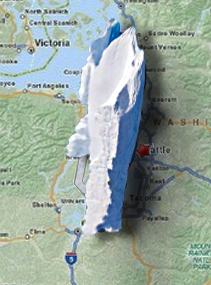from Steve Haushka
At 76 miles long and 17 miles wide, the iceberg would have extended from Olympia all the way to Sedro-Woolley, had it been in the Puget Sound basin.
Its actual location was near Antarctica’s Cape Adare where it was speeding along back in 2005 until it encountered an underwater shoal. It was shattered it into several pieces in just five hours.
One gets an idea of the vastness of iceberg B-15A by superimposing its shape over Puget Sound. Image by Seelye Martin/ UW
The sound file has been compressed by a factor of 200 so the event can be heard in less than two minutes, according to Seelye Martin, UW research professor in oceanography. He was lead author of a paper published last year in the Journal of Geophysical Research about the event.
The wind-like, whistling sounds are the harmonics created as the iceberg sticks and slips over the shoal. Listen as the cracking sounds build – that’s probably fractures propagating through the iceberg like an ice cube fracturing when put in a glass of water – and then a sharp shot. The eerie moaning sounds are probably from the resulting pieces of ice rubbing against each other.
Seven hundred miles away the strange song was recorded by seismic equipment at the South Pole, surprising scientists with how far the sound of the breakup propagated, Martin said. Instruments on the iceberg itself helped pinpoint the undersea shoal, which New Zealand scientists had imaged in the early 2000s, but which nobody realized was breaking up icebergs.
“This is a big navigational hazard for icebergs,” Martin says.

Iceberg B-15A was 76 miles long and 17 miles wide. Credit required: National Science Foundation
The iceberg B-15A was the largest remnant of an even larger iceberg called B-15 that calved from the Ross Ice Shelf in 2000. That massive berg would have stretched from Puget Sound to Portland.
Martin and other scientists are interested in changes in Antarctic and Greenland ice because melting contributes to sea level rise around the world. Martin, for example, participated last fall in NASA DC-8 aircraft flights from Punta Arenas, Chile, over Antarctica. Martin is a key player in Operation Ice Bridge, which is helping bridge a gap in ice-thickness information while NASA switches over to a new satellite system in 2015.
